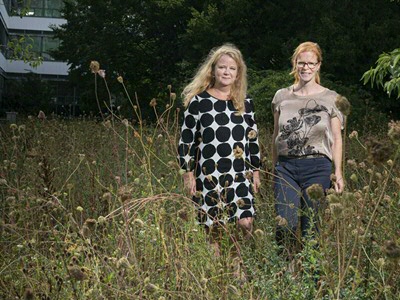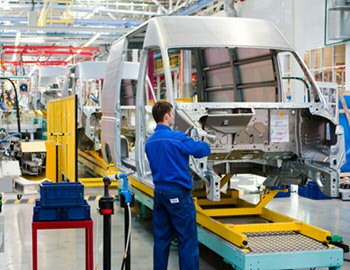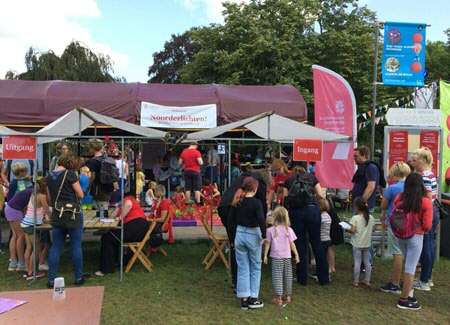Demonstrating that it can be done
Moniek Tromp and Marleen Kamperman share a lot in common. Both are young professors of chemistry at the Zernike Institute for Advanced Materials (ZIAM). Both joined the UG in 2018. Both are engaged in developing new materials. Both enjoy promoting science in the wider community, and both are seen as role models.

To start with that last point: who were their own role models? They don’t know. ‘I honestly couldn’t say,’ admits Tromp. ‘It’s a question I often get asked, but I didn’t really have a role model. My mother, maybe, in that she worked fulltime and managed to be there for us at home as well, but she worked in a different field. Kamperman also shrugs her shoulders. ‘I’ve never worked for a woman professor in a research team or anything.’ Well, perhaps that is the answer: maybe the essential characteristic of a role model for women scientists is precisely that ability to just quietly get on with doing your own thing in what has traditionally been a man’s world. And then years later, you sit up, look around you and are amazed. But more about that later.
Sustainable catalysts
Tromp and Kamperman are both engaged in developing new materials at the UG, but they are doing so from different perspectives and for different applications. As a professor of material chemistry, Tromp’s focus is on anorganic materials. These are materials that contain metals, such as metal oxides and salts. ‘Think, for example, of the materials used in batteries and fuel cells, or in the catalysts used to clean up vehicle exhaust fumes or in the production of certain chemicals and medicines,’ Tromp explains. ‘Many of the catalysts used in heavy industry were developed in the days before people were aware of environmental impact issues. They are based on scarce precious metals like palladium or platina, or on raw materials from politically unstable regions, or they produce toxic by-products, waste. That needs to change, so we are trying to develop sustainable catalysts based on plentiful natural raw materials and processes that produce less waste.’
One important aspect of her research is the development of techniques that will help her to study and characterize the materials she is researching. For example, Tromp has developed her own X-ray spectrometer. ‘In the same way that X-rays are used to examine bone fractures, we use X-rays to examine atoms and molecules and study how they react under different conditions. That allows us to characterize the structure and electronic properties of materials. Before, if we wanted to carry out X-ray measurements, we always had to travel to a synchrotron radiation facility in, say, France or Switzerland, or England. But there was no guarantee that we would be allocated sufficient time, and the travel distance was an issue, so now we have developed our own spectrometers that we can use 24 hours a day in our own lab.’

Automotive industry
So now Tromp is able to investigate issues such as why certain batteries explode and how the discharging of batteries works. ‘On the one hand, looking at these kinds of mechanisms sounds like very basic research, but once you understand how they work, the applications are very practical and direct.’ That’s why Tromp often carries out her research work in close collaboration with automotive and catalysis companies, like Varta and BMW.
Collaboration with industry? What approach does Tromp take to this hot potato? My question elicits an immediate snigger. ‘Oh, just because you call it a hot potato,’ she says. ‘We are working in collaboration with a large company at the moment on a catalyst that they are going to need in their factory next year. They wanted our help with the fundamental aspect of the research – that’s something they can’t do themselves. It’s important to set out clear agreements and stand your ground, but we can carry out our part of the task independently. You have to make sure that you have the freedom to do your own thing and that you can publish your research papers. Of course, that’s particularly important for PhD students and postdocs.’
Underwater adhesives
Put slightly irreverently, Kamperman is ‘into plastics,’ such as the long organic molecules commonly known as polymers. ‘My interest lies in the softer materials that are suitable for things like biomedical applications. At the moment, my focus is on adhesives that work well in a wet environment. These can be used, say, on the human body to close wounds using an adhesive rather than stitches. At present, I’m working on a project proposal involving seaweed cultivation. The current technique for cultivating seaweed is to tie seedlings to ropes, on which they can grow. But the plants come loose easily, and about 80 percent of the seaweed is lost. So, the hunt is on for an adhesive that can be used to stick the seedlings to the ropes. And since the ropes are hanging in the water, we have to select an adhesive that is not damaging for the environment.’
Kamperman likes to draw inspiration from nature. ‘Many natural organisms are really good at attaching themselves to wet surfaces. Take the mussel, for example. It has a little ‘foot’ which searches for a place on the surface that it can attach itself to. While the foot is on the surface, a protein-based adhesive thread is formed in the gland of the foot. The foot is then retracted and the mussel remains firmly stuck to the rock by the thread. So, I examine the chemical composition of the thread: what kind of proteins are in there and what makes it stick so well? And then we try to replicate those properties in synthetic polymers, without making the process as complicated as it is in nature. For our applications, a simple version is usually good enough.’
Pregnant lecturer
It really doesn’t sound at all as if Kamperman spends much time just ‘fiddling around in the hope that something useful will emerge,’ as she wrote last winter in the national newspaper de Volkskrant. In her column, ‘I am a professor but I don’t really know what I’m doing,’ she admitted to being amazed at having been awarded a professorship. Not everyone responded positively – and that’s putting it mildly. She was supposed to be a female role model, and here she was denigrating herself.
Which brings us back to the theme ‘women in the exact sciences.’ While Kamperman and Tromp did not have role models, they are fine with being regarded as role models themselves. Tromp says, ‘A lot of women say that they are not planning to stay in the academic world. They don’t see any other woman professors, so they assume it must be difficult. Nine years ago, I was the first woman professor in the chemistry faculty at the University of Munich, and I was also pregnant. Some of my colleagues felt I had no business lecturing in that state and wanted me to go home. But the students really liked it. It showed them that it is possible.’

Not all grey-haired men
That’s also the message Tromp puts across in the primary school programmes she is helping to develop. Woman captains, say, or pilots, are taken into classrooms to spark off discussions about gender inequality. ‘We find that children have genuinely never realized that women can do the jobs we do,’ Tromp says. ‘The gender bias is instilled in children as young as four or five, for example through the kinds of stories read to them, and then it’s very difficult to dislodge. I have always worked, but my own daughter told me at one point that she wants to be a mother when she grows up, so she won’t be able to work. And that’s despite me having set her a good example.’
In her outreach activities, Kamperman talks a lot about diversity in the sciences. Last summer, for example, she took her ‘magic molecules’ workshop, experiments and all, to the Universiteit van Noorderzon performing arts festival. ‘When you see how much the children enjoy themselves, you realize that it’s not that important whether they have understood everything. I love opening people’s eyes to how many different fields of science there are. My stories help children to see that scientists are not all grey-haired men wearing white coats.’
Curriculum vitae
Moniek Tromp, born in 1977, studied chemistry at the University of Utrecht, where she was also awarded a distinction for her PhD in 2004. She worked as a researcher and guest lecturer at the University of Southampton and as a visiting professor at the University of Amsterdam and the Technical University Munich. In June 2018, she joined the UG as Professor of Material Chemistry at the ZIAM.
Marleen Kamperman, born in 1979, studied chemistry at the UG and received her PhD from Cornell University in Ithaca, New York, in 2008. She worked as a postdoctoral researcher at the Leibniz Institute for New Materials in Saarbrucken and as a university lecturer and senior lecturer at Wageningen University & Research. She was appointed Professor of Polymer Science at the UG, ZIAM in 2018.
Text: Bert Platzer
More news
-
11 December 2025
Stormy planets and an unexpected atmosphere
-
09 December 2025
University of Groningen Professor at COP30: ‘There is always drama’
